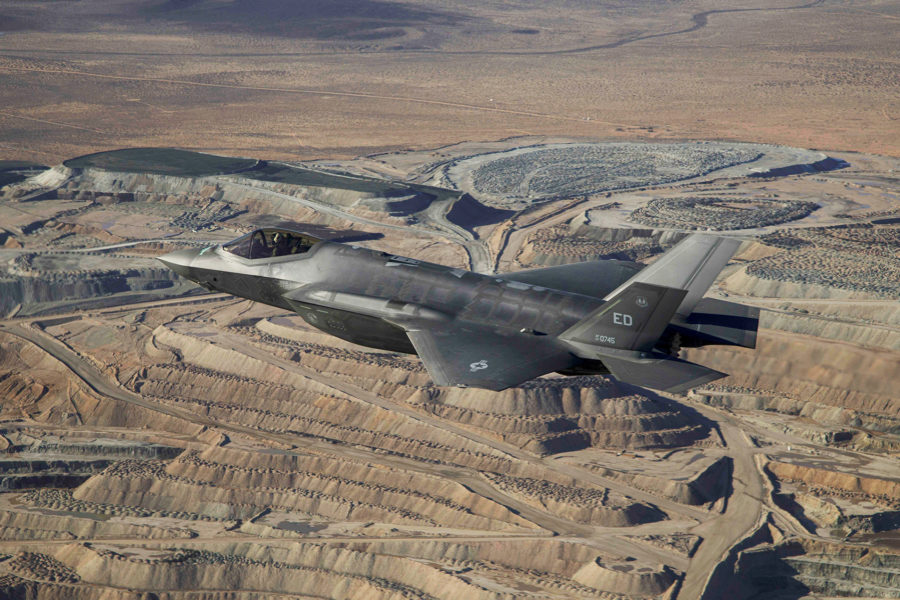The number of new F-35s dedicated to developmental testing would rise under the version of the 2025 National Defense Authorization Act passed by the House Armed Services Committee on May 22, yet another by lawmakers to put the spurs to the lagging program.
In the 2024 version of the bill, Congress adopted a provision to fund six F-35s to refresh the aging test fleet. For the 2025 bill, Rep. Rob Wittman (R-Va.) offered an amendment to raise that number to nine, and his proposal was approved by the HASC in a quick voice vote.
Lt. Gen. Michael Schmidt, F-35 program executive officer, told Air & Space Forces Magazine last fall that the program’s test fleet is tired, suffers from decreasing availability, and needs to be augmented with nine new airplanes configured with test gear. The combined test force has been supplemented with operationally-configured airplanes for some time, but they are not the optimal solution, Schmidt said.
A heavy campaign of F-35 testing is already underway and the load will increase as the Pentagon tries to complete testing of the Tech Refresh 3 hardware and software package. Once that’s complete, more than 80 improvements comprising the F-35 Block 4 upgrade will require test and evaluation, not including power and thermal testing pertaining to its F135 engine.
Schmidt has told Congress in budget testimony that Block 4 is being “reimagined,” and some elements of it planned to be fielded this decade will slip to the 2030s.
Under Wittman’s amendment, all the new test aircraft would be funded in Lot 18, which, along with Lot 19, has been under negotiation almost two years. In last year’s bill, the six airplanes would have come out of Lot 19. While the 2024 NDAA specified two of each variant as test jets, the new law would give the Pentagon flexibility to decide the mix.
The Joint Program Office has long contended that it has inadequate resources to support a high tempo of F-35 testing. Exasperated with the delays—which have resulted in more than 70 F-35s completed but not delivered because the Tech Refresh 3 upgrade built into them hasn’t finished testing—the HASC slashed F-35 purchases by up to 20 jets for fiscal 2025 and is redirecting the money to set up and staff a software laboratory and a flying system integration laboratory, among other test capacity enhancements.
“We are compelled to address the ongoing Joint Strike Fighter production challenge,” Wittman said in a statement attending the markup, noting comments by former head of U.S. Indo-Pacific Command Adm. Philip S. Davidson that China would be ready to invade Taiwan by 2027. “With over 100 JSF aircraft projected to stack up on the ramp waiting the needed TR-3/Block 4 upgrades and further challenges with getting the right capabilities in time to address the Davidson window, it is essential that we right-size our nation’s largest defense acquisition program.”
Wittman said the new provision puts the U.S. “in a good position that allows us to address the more egregious concerns identified” by the Pentagon’s Director of Operational Test and Evaluation, “a software independent review team, and the Government Accountability Office.” The adjustments to the F-35 program “will put the JSF program on the right path. We are not interested in placing blame for the program’s challenges; we are committed to delivering solutions.”
The GAO, in an F-35 report published last week, said it may take a year to go through the normal process of accepting and delivering the completed but parked jets. The JPO has said it has gotten approval from the F-35 user community to start accepting jets with less than the TR-3 hardware and software upgrade—a so-called “truncated” version of the upgrade—as soon as the software shows adequate stability in test. The JPO has not been able, however, to offer the metrics of what would constitute “stable” or when that status is expected to be achieved.
Lockheed Martin CEO Jim Taiclet said in the company’s last earnings call April 23 that the not-quite TR-3 upgrade, which he called a “combat training-capable” version, will likely be ready to go in the third quarter. He said it will allow F-35 users to start training with the TR-3 capabilities before they’re actually resident on the airplane.
The GAO—which issued its report before the FY 2025 markup—warned that the six new test F-35s already in flow won’t be delivered and configured for use until 2029.
